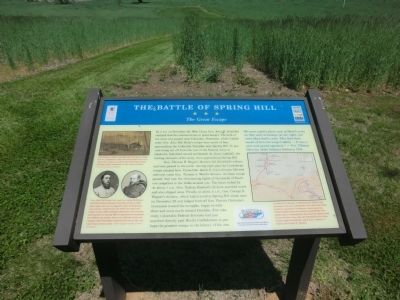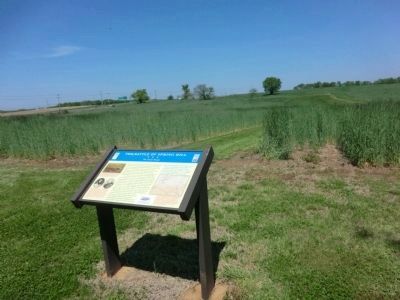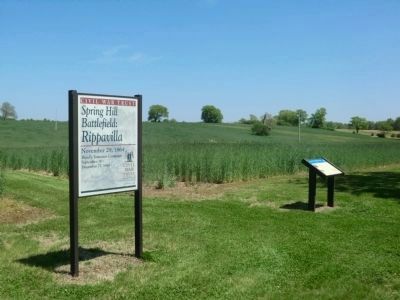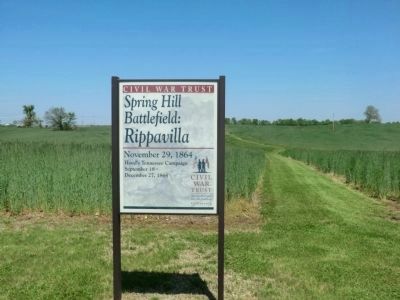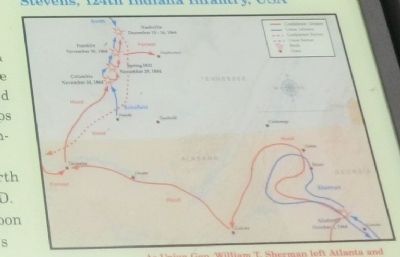Spring Hill in Maury County, Tennessee — The American South (East South Central)
The Battle of Spring Hill
The Great Escape
Gen. Thomas H. Ruger’s division led Schofield’s column and soon passed to the north, moving right past the Confederate troops camped here. Union Gen. Jacob D. Cox’s division followed and next came Gen. Thomas J. Wood’s division. As these troops passed, they saw the shimmering lights of thousands of Southern campfires in the fields around you. The hours ticked by. At about 1 a.m., Gen. Nathan Kimball’s division marched north and also slipped away. Finally, at about 5 a. m., Gen. George D Wagner’s division, which had arrived at Spring Hill about noon on November 29 and helped fend off Gen. Patrick Cleburne’s movement toward the turnpike, began to withdraw and move north toward Franklin. Five relatively vulnerable Federal divisions had just marched directly past Hood’s Confederates in perhaps the greatest escape in the history of the war.
“We came within plain view of Hood’s army as they were in bivouac to our right, not more than half a mile. They had thousands of fires burning brightly…It was a rare and grand spectacle.” — Pvt. Tillman Stevens, 124th Indiana Infantry, USA
(captions)
(upper left) With Federal soldiers marching directly past a campfire-lit Confederate camp near Spring Hill, the scene must have looked very much like this Edwin Forbes drawing, made somewhere in the eastern theater. Courtesy Library of Congress
(lower left) Gen. John Bell Hood, left, and Gen. John McAllister Schofield both graduated from West Point in 1853. They began the war on opposite sides as lieutenant and captain, respectively, but both were generals within a year. Both compiled impressive war records and marched to Spring Hill as experienced commanders. Within one month, Hood was relieved at his own request while Schofield continued his rise to the very top of the postwar army.— Both images courtesy Library of Congress
(lower right) As Union Gen. William T. Sherman left Atlanta and marched to the sea, Confederate Gen. John Bell Hood, joined by renowned Confederate cavalryman Gen. Nathan Bedford Forrest, moved toward Middle Tennessee. Here, at Spring Hill, Hood lost the opportunity to cut off Gen. John M. Schofield’s forces from Union troops at Nashville under Gens. Andrew J. Smith and George H. Thomas.
Erected by Tennessee Civil War Trails.
Topics and series. This historical marker is listed in this topic list: War, US Civil. In addition, it is included in the Tennessee Civil War Trails series list. A significant historical date for this entry is November 29, 1864.
Location. Marker has been reported permanently removed. It was located near 35° 43.921′ N, 86° 57.177′ W. Marker was in Spring Hill, Tennessee, in Maury County. Marker could be reached from Main Street (U.S. 31) half a mile south of Saturn Parkway, on the left when traveling west. The marker is located on the entrance road to the Rippavilla Plantation. Touch for map. Marker was at or near this postal address: 5700 Main Street, Spring Hill TN 37174, United States of America.
We have been informed that this sign or monument is no longer there and will not be replaced. This page is an archival view of what was.
Other nearby markers. At least 8 other markers are within walking distance of this location. A different marker also named The Battle of Spring Hill (here, next to this marker); Slave Fields To Battlegrounds (here, next to this marker); Rippa Villa (within shouting distance of this marker); a different marker also named Rippa Villa (within shouting distance of this marker); Rippavilla Plantation (about 600 feet away, measured in a direct line); a different marker also named The Battle of Spring Hill (approx. 0.2 miles away); a different marker also named The Battle of Spring Hill (approx. 0.2 miles away); Billy Direct (approx. 0.6 miles away). Touch for a list and map of all markers in Spring Hill.
Credits. This page was last revised on October 26, 2022. It was originally submitted on July 5, 2014, by Don Morfe of Baltimore, Maryland. This page has been viewed 1,128 times since then and 47 times this year. Last updated on October 25, 2022, by Bradley Owen of Morgantown, West Virginia. Photos: 1, 2, 3, 4, 5. submitted on July 5, 2014, by Don Morfe of Baltimore, Maryland. • J. Makali Bruton was the editor who published this page.
